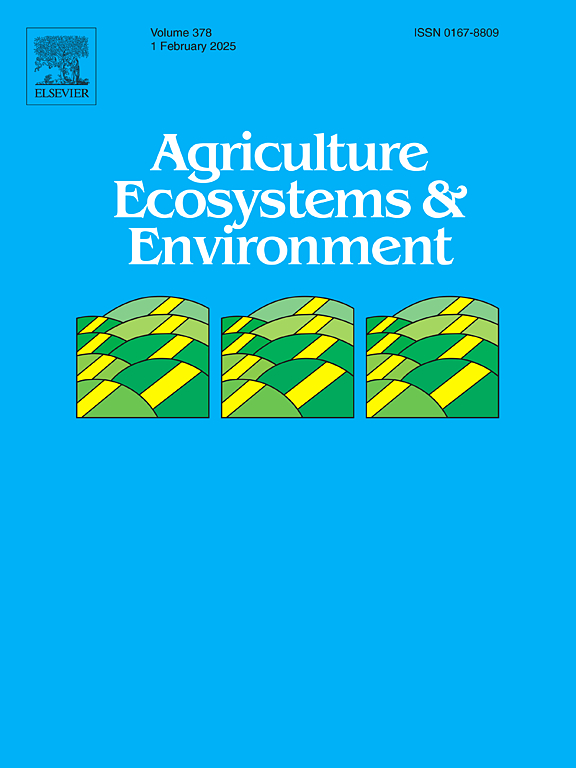Sustainable grassland management through an intercropping system based on cutting optimization
IF 6.4
1区 农林科学
Q1 AGRICULTURE, MULTIDISCIPLINARY
引用次数: 0
Abstract
In arid and semi-arid regions, the restoration of degraded grasslands necessitates strategies that balance agricultural production with ecological sustainability. Large-scale alfalfa cultivation has been implemented in the Loess Plateau of China to establish cultivated grassland aimed at vegetation recovery and soil erosion control. However, this approach presents a critical dilemma: although alfalfa effectively stabilizes soil and supports local livelihoods, its high water demand exacerbates the already severe water scarcity that exists in such dryland ecosystems. To address this issue, a two-year field experiment was conducted in Qingyang, Gansu Province to evaluate the effects of monocultures and intercropping of wheat and alfalfa, along with precision cutting management of alfalfa, on yield, water use (WU), and water productivity (WP). Three cropping patterns were implemented: sole wheat, sole alfalfa, and wheat/alfalfa intercropping with seven alfalfa cutting treatments (T-20C1, T-20C2, T-20C3, T-10C1, T-10C2, T-10C3, and T). Results indicated that a significant increase in productivity of the intercropping system by 8.7 %![]() 21.2 % in 2022 and 16.3 %
21.2 % in 2022 and 16.3 %![]() 31.0 % in 2023 compared to that of monocultures. The land equivalent ratio of the intercropping system under the T-10C2 treatment reached 1.15 in 2022 and 1.21 in 2023. Compared with that of sole wheat, the yield of intercropped wheat under the T treatment was significantly reduced, by 25.6 % in 2022 and 12.7 % in 2023. Except for the T-20C1 treatment in 2022, the yield of intercropped wheat under other treatments did not exhibit statistically significant differences when compared with that of sole wheat in both 2022 and 2023. Compared with the yield under the T treatment, the yield of intercropped wheat under the T-10C1, T-20C3, T-10C2, and T-10 treatments increased significantly, by 23.3 %
31.0 % in 2023 compared to that of monocultures. The land equivalent ratio of the intercropping system under the T-10C2 treatment reached 1.15 in 2022 and 1.21 in 2023. Compared with that of sole wheat, the yield of intercropped wheat under the T treatment was significantly reduced, by 25.6 % in 2022 and 12.7 % in 2023. Except for the T-20C1 treatment in 2022, the yield of intercropped wheat under other treatments did not exhibit statistically significant differences when compared with that of sole wheat in both 2022 and 2023. Compared with the yield under the T treatment, the yield of intercropped wheat under the T-10C1, T-20C3, T-10C2, and T-10 treatments increased significantly, by 23.3 %![]() 46.3 % in 2022 and 13.9 %
46.3 % in 2022 and 13.9 %![]() 20.4 % in 2023. Compared with that of sole alfalfa, the yield of intercropped alfalfa increased significantly, by 45.4 %
20.4 % in 2023. Compared with that of sole alfalfa, the yield of intercropped alfalfa increased significantly, by 45.4 %![]() 48.8 % in 2022 and 49.7 %
48.8 % in 2022 and 49.7 %![]() 44.6 % in 2023. Compared with the sole cropping system, the WU of all treatments in the intercropping system decreased by 1.1 %
44.6 % in 2023. Compared with the sole cropping system, the WU of all treatments in the intercropping system decreased by 1.1 %![]() 13.1 % compared to the sole cropping system in 2022, while the WP increased by 0.1 %
13.1 % compared to the sole cropping system in 2022, while the WP increased by 0.1 %![]() 24.0 % in 2022 and 7.7 %
24.0 % in 2022 and 7.7 %![]() 23.5 % in 2023. Overall, results indicated that optimized cutting of alfalfa improves WP and reduces total WU in wheat/alfalfa intercropping systems. This provides a water-saving solution for cultivated grasslands in arid areas, achieving a synergy between ecological restoration and agricultural WU.
23.5 % in 2023. Overall, results indicated that optimized cutting of alfalfa improves WP and reduces total WU in wheat/alfalfa intercropping systems. This provides a water-saving solution for cultivated grasslands in arid areas, achieving a synergy between ecological restoration and agricultural WU.
基于刈割优化的间作系统草地可持续管理
在干旱和半干旱地区,退化草原的恢复需要平衡农业生产与生态可持续性的战略。黄土高原大规模种植紫花苜蓿,建立以恢复植被和控制水土流失为目的的人工草地。然而,这种方法带来了一个关键的困境:尽管苜蓿有效地稳定了土壤并支持了当地的生计,但它的高需水量加剧了干旱地区生态系统中已经存在的严重缺水问题。为了解决这一问题,在甘肃庆阳进行了为期两年的田间试验,评价了小麦与苜蓿单作和间作以及苜蓿精割管理对产量、水分利用(WU)和水分生产力(WP)的影响。采用小麦、苜蓿和小麦/苜蓿间作3种种植模式,7个苜蓿刈割处理(T- 20c1、T- 20c2、T- 20c3、T- 10c1、T- 10c2、T- 10c3和T)。结果表明,与单作相比,间作在2022年和2023年的产量分别显著提高8.7%、21.2%和16.3%、31.0%。T-10C2处理间作制度的土地当量比在2022年达到1.15,在2023年达到1.21。与单作小麦相比,T处理下间作小麦产量显著降低,2022年减产25.6%,2023年减产12.7%。除了2022年的T-20C1处理外,其他处理的间作小麦产量与2022年和2023年的单作小麦产量均无显著差异。与T处理相比,T- 10c1、T- 20c3、T- 10c2和T-10处理的间作小麦产量显著提高,2022年增产23.3%、46.3%,2023年增产13.9%、20.4%。与单作苜蓿相比,间作苜蓿产量显著提高,2022年和2023年分别增产45.4%、48.8%和49.7%、44.6%。与单作相比,2022年套作各处理的WU比单作减少了1.1% - 13.1%,而WP在2022年和2023年分别增加了0.1% - 24.0%和7.7% - 23.5%。综上所述,苜蓿刈割优化提高了小麦/苜蓿间作系统的WP,降低了总WU。这为干旱地区的耕地草原提供了节水解决方案,实现了生态修复与农业用水的协同。
本文章由计算机程序翻译,如有差异,请以英文原文为准。
求助全文
约1分钟内获得全文
求助全文
来源期刊

Agriculture, Ecosystems & Environment
环境科学-环境科学
CiteScore
11.70
自引率
9.10%
发文量
392
审稿时长
26 days
期刊介绍:
Agriculture, Ecosystems and Environment publishes scientific articles dealing with the interface between agroecosystems and the natural environment, specifically how agriculture influences the environment and how changes in that environment impact agroecosystems. Preference is given to papers from experimental and observational research at the field, system or landscape level, from studies that enhance our understanding of processes using data-based biophysical modelling, and papers that bridge scientific disciplines and integrate knowledge. All papers should be placed in an international or wide comparative context.
 求助内容:
求助内容: 应助结果提醒方式:
应助结果提醒方式:


